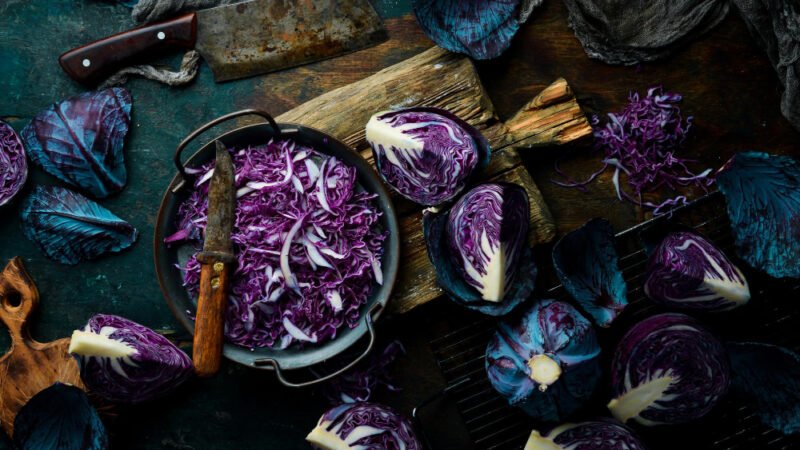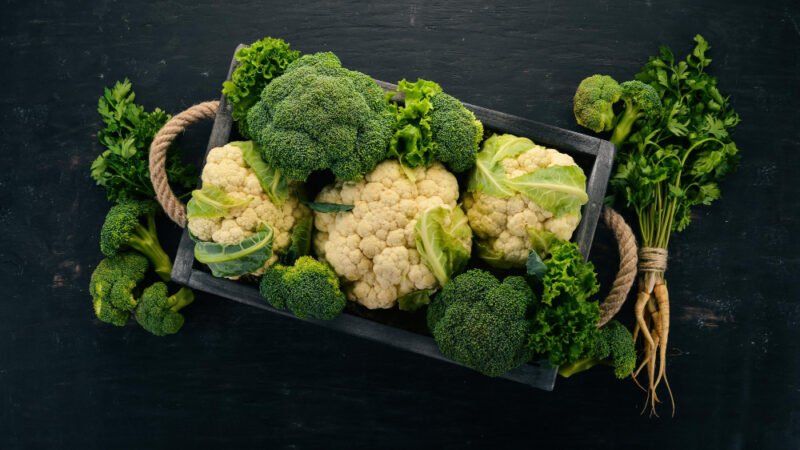Eating this 1 cruciferous vegetable daily could help you regulate your blood sugar & prevent diabeties
Diabetes is a prevalent health condition affecting over 300 million people worldwide.
The onset of diabetes is often a result of poor lifestyle choices over time. Unfortunately, many individuals are unaware of the detrimental effects until their loved ones are diagnosed with the disease.
As someone who has experienced the impact of diabetes firsthand, with my mother being diagnosed and suffering from its complications, I am passionate about spreading awareness and knowledge to help combat this condition. This article will explore how incorporating cruciferous vegetables into your diet can be a powerful tool in protecting against diabetes.
One: Regulation of Blood Sugar Levels to prevent diabeties
One of the key reasons why cruciferous vegetables, such as broccoli, can help combat diabetes is their ability to regulate blood sugar levels.
Research has shown that these vegetables contain a compound that can positively impact gene expression associated with diabetes, potentially reversing its effects (Source 1). This compound, sulforaphane, has been found to activate a protein called nuclear factor erythroid 2-related factor 2 (Nrf2), which is crucial in regulating blood sugar levels and protecting against oxidative stress (Source 10).
By incorporating cruciferous vegetables into your diet, you can harness the power of sulforaphane to support healthy blood sugar control.
In a study conducted on diabetic rats, it was discovered that a compound found in cruciferous vegetables produced remarkable results (Source 2).
The study then progressed to human trials, where 97 individuals with type 2 diabetes and obesity were given concentrated broccoli sprout extracts. Over the 12-week study, these participants demonstrated a significant decrease in fasting blood glucose levels compared to the control group (Source 2).
This research highlights the potential of cruciferous vegetables, such as broccoli, in regulating blood sugar and preventing the onset of diabetes.

Two: High Fiber foods
Broccoli is the king of blood sugar control due to its high fibre content. Just one cup of steamed broccoli contains five grams of fibre (Source 3). Fibre-rich foods are crucial in managing and controlling blood sugar levels, preventing sudden spikes in glucose levels that can harm individuals with diabetes (Source 4). Fibre slows down the absorption of sugar into the bloodstream, providing a more gradual and sustained release of glucose. This helps prevent blood sugar spikes and promotes stable blood sugar levels (Source 11).
Moreover, the soluble fibre found in broccoli improves insulin sensitivity by providing nutrient-rich food to the gut bacteria. A healthy gut microbiome enhances digestion and assimilation of food, aiding in blood sugar regulation (Source 5). Soluble fibre also forms a gel-like substance in the intestines, which helps to slow down the digestion and absorption of carbohydrates, further contributing to blood sugar control (Source 12). Including cruciferous vegetables like broccoli, cauliflower, cabbage, collard greens, and Brussels sprouts can provide the soluble fibre necessary for blood sugar control.
Three: Mitigating Oxidative Stress and Inflammation
Broccoli helps regulate blood sugar levels and plays a vital role in limiting oxidative stress and reducing inflammation within the body. Oxidative stress occurs when there is an imbalance between the production of harmful free radicals and the body’s ability to neutralize them. Chronic inflammation and oxidative stress are closely linked to the development and progression of diabetes (Source 6).
Consuming broccoli, with its abundant vitamin C, can boost the immune system and manage overall health (Source 7). Vitamin C is a potent antioxidant, helping neutralize free radicals and reduce oxidative stress (Source 13). By reducing oxidative stress, broccoli helps protect the cells and tissues of the body from damage caused by high glucose levels in individuals with diabetes.
In addition to vitamin C, broccoli contains other beneficial compounds that contribute to its anti-inflammatory properties. One such compound is sulforaphane, which regulates blood sugar levels and exhibits potent anti-inflammatory effects (Source 14). Chronic inflammation is associated with insulin resistance and impaired glucose metabolism, both of which are key factors in the development of diabetes (Source 15). Broccoli can help improve insulin sensitivity and support healthy blood sugar control by reducing inflammation.
Furthermore, the various nutrients found in broccoli contribute to strengthening bones, improving skin condition, and protecting the heart tissue from damage (Source 7). Diabetes increases the risk of cardiovascular complications, and broccoli’s cardioprotective properties can help mitigate this risk. The combination of its anti-inflammatory and antioxidant properties makes broccoli a valuable addition to a diabetes-friendly diet.

Four: Convenient Consumption Options
While consuming five kilograms of broccoli daily may seem daunting, there are more convenient ways to incorporate this powerful vegetable into your diet. Concentrated broccoli powder or capsules are available, allowing you to enjoy the benefits without the need for excessive broccoli consumption (Source 8). These concentrated forms provide a convenient and efficient means of incorporating broccoli into your routine.
Broccoli powder can be easily added to various foods and drinks throughout the day, making it a hassle-free option.
Mix it into smoothies, sprinkle it on salads, or stir it into soups and sauces. The versatility of broccoli powder allows you to reap the benefits of this diabetes-fighting vegetable without drastically altering your diet.
Additionally, incorporating broccoli powder into your meals and smoothies can enhance their nutritional value. Broccoli is rich in vitamins, minerals, and antioxidants that support overall health and well-being. Adding it to your favourite recipes can boost their nutritional content and make them even more diabetes-friendly.
Five: Broccoli’s Role in Weight Management
Obesity is a significant risk factor for developing type 2 diabetes. Incorporating broccoli and other cruciferous vegetables into your diet can aid in weight management, which in turn helps prevent diabetes. Broccoli is low in calories and fibre, making it a satisfying and nutrient-dense food choice (Source 16). The high fibre content helps promote feelings of fullness and can reduce overall calorie intake, supporting weight loss or weight maintenance goals (Source 17). By including broccoli in your meals, you can contribute to a balanced and calorie-controlled diet, essential for diabetes prevention and management.
Furthermore, broccoli’s low glycemic index (GI) benefits individuals with diabetes or those at risk.
The GI measures how quickly food raises blood sugar levels. Foods with a low GI are digested and absorbed more slowly, resulting in a slower and more gradual rise in blood sugar levels (Source 18). This helps maintain stable blood sugar levels and reduces the risk of glucose spikes. You can support healthy blood sugar control and weight management by including low-GI foods like broccoli in your meals.
Six: A Variety of Cruciferous Vegetables
While broccoli has been the focus of much research regarding its potential benefits for diabetes, it’s important to note that other cruciferous vegetables offer similar advantages. Cauliflower, cabbage, collard greens, and Brussels sprouts are all part of the cruciferous vegetable family and share many health-promoting properties.
Including various cruciferous vegetables in your diet ensures a diverse range of nutrients and compounds supporting blood sugar control and overall health. Each vegetable offers its unique combination of vitamins, minerals, fibre, and antioxidants, contributing to the prevention of diabetes and its complications. You can enjoy various flavours, textures, and nutritional benefits by incorporating these vegetables into your meals and recipes.
Cauliflower, for example, is another cruciferous vegetable that deserves attention in the fight against diabetes. It is rich in fibre, vitamins, and minerals, making it an excellent addition to a diabetes-friendly diet (Source 19). Cauliflower can be used as a low-carbohydrate alternative to rice or mashed potatoes, providing a satisfying and nutritious option while helping to control blood sugar levels.
Cabbage, known for its crunchy texture and versatility, is also a valuable vegetable in diabetes prevention.
It is low in calories and carbohydrates but packed with essential nutrients and antioxidants (Source 20). Incorporating cabbage into salads, stir-fries, or soups adds a refreshing and nutritious element to your meals while supporting blood sugar control.
Collard greens, a dark leafy green vegetable, are rich in fibre, vitamins A and K, and antioxidants (Source 21). They offer numerous health benefits, including promoting healthy digestion and supporting cardiovascular health. Including collard greens in your diet can help manage blood sugar levels and reduce the risk of developing diabetes.
Brussels sprouts, often underrated, are a nutritional powerhouse. They are high in fibre, vitamin C, and antioxidants, making them an excellent choice for diabetes prevention (Source 22). Brussels sprouts can be roasted, steamed, or sautéed to bring out their delicious flavour and complement various dishes.
By incorporating a variety of cruciferous vegetables into your diet, you can diversify your nutrient intake and maximize the potential benefits of diabetes prevention. Experimenting with different cooking methods, recipes, and combinations can make your meals exciting and enjoyable while promoting your health.
Conclusion
Incorporating cruciferous vegetables, such as broccoli, into your diet can provide significant benefits in combating diabetes and maintaining overall health. The regulation of blood sugar levels, high fibre content, mitigation of oxidative stress and inflammation, convenient consumption options, contribution to weight management, and the availability of various cruciferous vegetables all contribute to their effectiveness in protecting against diabetes.
Research has shown promising results in terms of blood sugar control and diabetes prevention through the consumption of cruciferous vegetables. However, it is important to note that a balanced and varied diet, regular physical activity, and overall healthy lifestyle choices are crucial in managing and preventing diabetes.
By making conscious choices to include cruciferous vegetables like broccoli, cauliflower, cabbage, collard greens, and Brussels sprouts in your meals, you can take proactive steps towards protecting yourself against diabetes and its complications. So, get creative with your broccoli consumption, try different recipes, and embrace the power of these remarkable vegetables in your journey towards optimal health and diabetes prevention.
Research
You can also follow me on YouTube for the latest, science-backed research on health, weight and weight training, and an endless supply of healthy recipes.
You may also like to download my FREE Fat Loss Recipe book.
I appreciate your support.

1 Comment